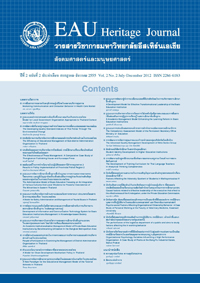A Model for Clean Development Mechanism Policy in Thailand
Keywords:
นโยบายสาธารณะ, กลไกการพัฒนาที่สะอาด, CDM, public policy, clean development mechanismAbstract
The purpose of this study was to explore and examine a model for Clean Development Mechanism (CDM) policy in Thailand with mixed methodology research. According to unit of analysis, the questionnaires were sent to CDM project developers who submitted Letter of Agreement (LoA), totally 125 participants. The data was analyzed using Statistical packages (Moment Structures). They presented the path diagram for correlations between the critically causal factors (predictors) and the CDM policy performance. CDM policy process model in Thailand aimed to identify attractive factors and elements which were positive force necessary to implement CDM project, meanwhile naming barrier factors which were negative force to suppress growth rate of CDM project in Thailand. Both types of factors were through investigated and sorted by statistical ranking. Causal factors in this study on the basis of relevant literatures, they were summed up into 5 main categories as follows: (1) Economic and social condition, (2) Policy condition, (3) Policy Resources, (4) Communication, and (5) Policy disposition respectively. On the other hand, CDM policy performance as policy output, was examined with exploratory factor analysis. It was measured in terms of following issues: (1) Outcome of taxation policy, (2) Outcome of financial provision, (3) Outcome of technological support, and (4) Policy Impact, respectively. As a result of R2, the five causal factors as could explain the CDM policy performance of 70.1 %. In consequence of AMOS outputs, they totally showed that the model in the figure fitted data appropriately. The future of post-2012 CDM policy in Thailand, the study revealed that CDM would be ongoing. However, it might transform to be voluntary, and not legally binding.
ตัวแบบนโยบายกลไกการพัฒนาที่สะอาดของประเทศไทย
วัตถุประสงค์ของการศึกษา คือ การสำรวจและตรวจสอบแบบจำลองสำหรับกลไกการพัฒนาที่สะอาด (CDM) ด้วยวิธีการวิจัยแบบผสม โดยการวิเคราะห์จากเอกสารและใช้แบบสอบถามความคิดเห็นจำนวน 125 ชุด วิเคราะห์ข้อมูล โดยใช้โปรแกรม สถิติ ผลการวิจัย พบว่า ปัจจัยห้าประการเป็นสาเหตุที่สามารถอธิบายผลการดำเนินงานตามนโยบาย ของ CDM แสดงให้เห็นว่า รูปแบบนี้มีข้อมูลอย่างเหมาะสม อนาคตของโพสต์-2012 นโยบาย CDM ในประเทศไทย การศึกษาพบว่าโครงการ CDM จะต่อเนื่องแต่อาจเปลี่ยนไปเป็นความสมัครใจและไม่ได้ผลผูกพันตามกฎหมาย





